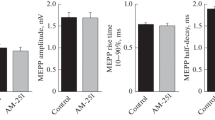Abstract
In mouse diaphragm, the increase in frequency of mini end-plate potentials (f mepp), by Ca2+ or Ba2+ in 20 mM K+, was reversibly inhibited by Zn2+ in a manner consistent with competition between Zn2+ and Ca2+ at a site which interacts with only one atom of Zn with an apparent dissociation constant (Ki′) of about 0.015 mM. Between 0.5 mM and 2 mM, Zn2+ caused a rapid and reversible dose-dependent increasef mepp in 20 mM K+/0 Ca2+. Prolonged or repeated exposure to Zn2+ produced a slow increase inf mepp followed by a decline, which once started, was not modified by of Zn2+. The time course was prolonged in raised Mg2+, bekanamycin, or in 5 mM K+ solution, and graded with Zn2+ concentration, but total numbers of MEPPs induced by 0.1 mM, 1 mM or 4 mM Zn2+ were not significantly different. Whenf mepp fell it became insensitive to Ca2+, Ba2+, La3+ (in 20 mM K+), ethanol and raised osmotic pressure. Before complete block of responses to Ca2+, the Ca2+/fmepp dose/response curve in 20 mM K+ was shifted to the right. These results indicate that Zn2+ enters the terminal via voltage-gated Ca2+ channels that interact in a complex way with these ions and then acts (a) as a partial agonist at sites where Ca2+ normally governs transmitter release, and (b) to produce irreversible changes in the nerve terminal, associated with a rise and subsequent fall off mepp and loss of sensitivity of the release mechanism to Ca2+ and other agents.
Similar content being viewed by others
References
Balnave RJ, Gage PW (1973) The inhibitory effect of manganese on transmitter release at the neuromuscular junction of the toad. Br J Pharmacol 47: 339–352
Cooke JD, Quastel DMJ (1973) Transmitter release by mammalian motor nerve terminals in response to focal polarization. J Physiol (Lond) 228: 377–405
Cooper GP, Suszkiw JB, Manalis RS (1984) Heavy metals; effects on synaptic transmission Neurotoxicology 5: 247–266
Curtis MJ, Quastel DMJ, Saint DA (1986) Lanthanum as a surrogate for calcium in transmitter release at the neuromuscular junction. J Physiol (Lond) 373: 243–260
Dodge FA Jr, Rahamimoff R (1967) Cooperative actions of calcium ions in transmitter release at the neuromuscular junction. J Physiol (Lond) 193: 419–432
Gage PW, Quastel DMJ (1966) Competition between sodium and calcium ions in transmitter release at mammalian neuromuscular junctions. J Physiol (Lond) 185: 95–123
Guan YY, Quastel DMJ, Saint DA (1987) Multiple actions of cadmium on transmitter release at the mouse neuromuscular junction. Can J Physiol Pharmacol 65: 2131–2136
Guan YY, Quastel DMJ, Saint DA (1988) Single Ca2+ entry and transmitter release systems at the neuromuscular synapse. Synapse 2: 558–564
Hess P, Tsien RW (1984) Mechanism of ion permeation through calcium channels. Nature 309: 453–456
Lin-Shiau SY, Fu WP (1980) Effects of divalent cations on neuromuscular transmission in the chick. Eur J Pharmacol 64: 259–269
Nishimura M (1987) Zinc competitively inhibits calcium-dependent release of transmitter at the mouse neuromuscular junction. Pflügers Arch 410: 623–626
Nishimura M (1988) Zn2+ stimulates spontaneous transmitter release at mouse neuromuscular junctions. Br J Pharmacol 93: 430–436
Quastel DMJ, Saint DA (1986) Calcium cooperativity in calcium entry and calcium action, and its implications with regard to facilitation, at the mouse motor nerve terminal. In: Rahamimoff R, Katz R (eds) Calcium, neuronal function and transmitter release. Martinus Nijhoff, Boston, p 141
Quastel DMJ, Saint DA (1988) Transmitter release at mouse motor nerve terminals mediated by temporary accumulation of intracellular barium. J Physiol (Lond) 406: 55–73
Quastel DMJ, Hackett JT, Cooke JD (1971) Calcium: is it required for transmitter secretion? Science 172: 1034–1036
Saint DA, McLarnon JG, Quastel DMJ (1987) Anion permeability of motor nerve terminals. Pflügers Arch 409: 258–264
Silen L, Martell AE (1971) Stability constants. The Chemical Society, Special publication 25 [Suppl. 1], London p 623
Silinsky EM (1977) An estimate of the equilibrium dissociation constant for calcium as an antagonist of evoked acetylcholine release: implications for excitation-contraction coupling. Br J Pharmacol 61: 691–693
Silinsky EM (1985) The biophysical pharmacology of calcium-dependent acetylcholine secretion. Pharmacol Rev 37: 81–132
Weakly JN (1973) The action of cobalt ions on neuromuscular transmission in the frog. J Physiol (Lond) 234: 597–612
Author information
Authors and Affiliations
Rights and permissions
About this article
Cite this article
Wang, Y.X., Quastel, D.M.J. Multiple actions of zinc on transmitter release at mouse end-plates. Pflugers Arch. 415, 582–587 (1990). https://doi.org/10.1007/BF02583509
Received:
Revised:
Accepted:
Issue Date:
DOI: https://doi.org/10.1007/BF02583509




